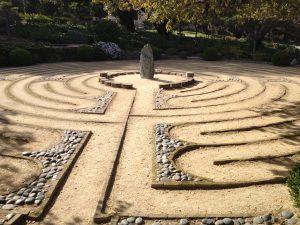
We tend to think spirituality is like creativity—you either have it or you don’t. In fact, spirituality and creativity can both be developed and nurtured. The only thing needed is attention.
We all have spiritual thoughts, even though we may not categorize them as such. These are the thoughts of wonder you might have looking at your newborn son. Or the feeling of oneness you might feel as you connect with a character from a movie. People who consider themselves “spiritual” recognize these moments and honor them, maybe just pausing a few seconds to feel grateful to God or the universe at large.
Spiritual people also go the next step and seek out transcendent experiences. When was the last time you took a hike, read a poem, tinkered in your garden or played with children just for fun? Everyone has a different way of experiencing spirituality—that sense we are part of something bigger—in their lives. Could you incorporate more of these activities in your life? What would it look like, for example, to spend more time outside? Perhaps you only have time for a 15-minute stroll around the block after dinner. Or maybe you could keep a book of your favorite poems next to your bed to dip into from time to time.
We need food to grow spirituality and we need to make it easy for ourselves to access this food. This takes some intentionality and the more you incorporate life-giving activities, the more you will seek them out. Think of the last time, for instance, you enjoyed nature. Being among trees and disconnected from technology often restores us. It motivates us to do more of the same. Often, however, we get consumed by the urgent tasks of day-to-day life. It takes determination and active memory of the good times we’ve had to carve out those spiritually-sustaining moments.
Spirituality versus religion
These days the fastest-growing category of religion is the “spiritual but not religious.” These are people who seek to nurture their souls in ways that don’t involve organized religion. They may find sustenance in some of the ways mentioned above or in their yoga class or art practice. Maybe you identify with this. You are turned off by some of the hypocrisy in organized religion or just plain bored with church services. But organized religion is still flourishing in some places and its traditions have much to teach. Even those who don’t follow religion per se could adapt some of their meaningful traditions and rituals of ancient faiths into everyday life.
• Weekly rituals. Growing up, my friend Camille observed the weekly Shabbat with her family. They gathered together every Friday night around the dining room table, where her father lit candles and said a prayer to welcome the beginning of the Sabbath. The practice lent meaning and rhythm to the week and reminded the family of their shared values. Anyone who happened to be in their home on a Friday night (including many times me!) was welcome to participate.
Back in 2015 I visited my friend Brian at his home in Massachusetts. It was April but it had recently snowed and everything was blanketed in a layer of white. I was interested in visiting the famous Walden Pond, where Henry David Thoreau lived and wrote his treatise on communing with nature. So Brian, his wife Cindy and I took a short drive and spent a morning walking around the pond (see photo below). We all loved the experience. Brian loved it so much that after I left, he made walking the pond a weekly ritual. He always thanks me for initiating that ritual, which became such an important part of his week. Brian is not “religious,” but his practice was just as spiritual as if he stayed home and prayed with candles.

• Daily rituals. For a time I experimented with “praying the hours,” an ancient form of prayer in which set prayers are said three times a day. I enjoyed the beauty of the language and the discipline of stopping my activity and turning to God. As with many rituals, I eventually lost motivation and turned to something else. But that was OK. From time to time we need to change our behaviors to keep things fresh and our spirit alive.
These days I am practicing centering prayer each morning. Centering prayer is like meditation. You focus on a few words or a phrase for about 20 minutes and keep returning to those words when your mind wanders. I am finding centering prayer a challenge but also relaxing. It is satisfying to “turn off” my mind and “center” myself for a short time each morning.
• Life rituals. My cousin has created a row of stone markers in his garden. He took this idea from the Old Testament. For each major life event, like the birth of a child or completion of his doctoral degree, my cousin placed a stone to commemorate the event. I have another friend whose parents marked each New Year’s Eve by encouraging their children to write their hopes for the year and share them with each other. My friend has carried this tradition on to her own family.
The Old is New
It may be surprising for the non-religious, but many old faiths are in a time of renaissance, as people today rediscover old practices. This is the case with the growth of contemplative Christianity, as Christians today plumb their history to enjoy the writings of mystics like St. John of the Cross or St. Teresa or engage in centering prayer or walk a labyrinth.

I’ve discovered in contemplative Christianity an approach to faith that honors my imagination and creativity. In fact I decided to become a spiritual director so I could shepherd others down a path of more contemplative, reflective living. A spiritual director is a person trained to listen to others’ stories, especially around their spiritual life. The director helps the person discover the holy happenings in their life, to see where God has been present for them, and discuss spiritual practices. Directors usually meet with “directees” once a month for an hour. Most spiritual directors are Christians, but there are also Jewish and Buddhist directors. Many spiritual directors meet with people who are “spiritual, but not religious” or perhaps on the edges of a religion.
Spiritual direction is just one of the old practices people are rediscovering. Another favorite practice of mine is imaginative prayer. St. Ignatius first proposed imaginative prayer in the 16th century. In this type of prayer you typically read a passage of the Bible (often stories about Jesus) with your full imagination. You place yourself in the story, imagining the sights, sounds and smells of the passage. You pay attention to images that strike you and ask lots of questions. Typically, you read a passage slowly and several times. This practice is often done in groups and it’s remarkable how the same passage can be read and imagined in different ways by different people. The techniques of imaginative prayer don’t need to be limited to reading the Bible. They could be used in reading poetry or meditating on a piece of art. If you are interested in experiencing imaginative prayer, let me know and I can direct you a group doing this,
For more information about spiritual direction, check out the Spiritual Directors International web site (https://www.sdiworld.org/) and to learn more about contemplative Christianity, check out Contemplative Outreach (https://www.contemplativeoutreach.org). In addition, there are many wonderful retreat houses across the country that offer workshops and retreats focusing on contemplative practices. Many of these retreat houses are Catholic but are open to all.
It’s never too late to start a spiritual practice. It may change your life.


You are a very GOOD writer. Thank you for being so clarifying about your life journey.